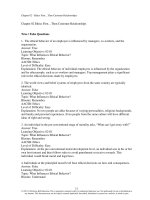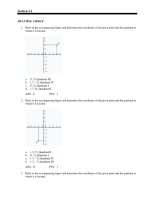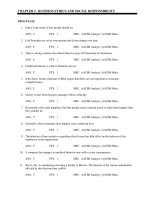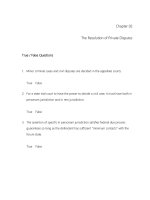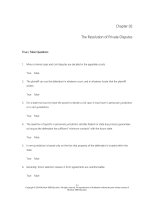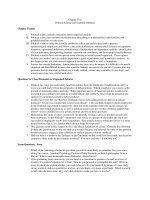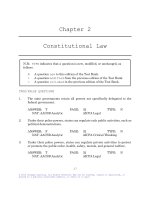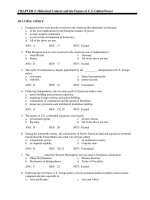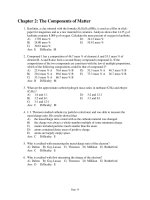Cengage advantage books the politics of united states foreign policy 6th edition rosati test bank
Bạn đang xem bản rút gọn của tài liệu. Xem và tải ngay bản đầy đủ của tài liệu tại đây (223.89 KB, 5 trang )
CHAPTER 2: Historical Context and the Future of U.S. Global Power
MULTIPLE CHOICE
1. European powers were heavily involved in the American Revolutionary war because
a. of the wars implications for the European balance of power.
b. to keep America isolationist.
c. to prevent the development of democracy.
d. All of the above are true.
ANS: A
REF: 17
NOT: Factual
2. What European powers were involved in the American war of independence?
a. Great Britain
c. Germany
b. France
d. All of the above are true.
ANS: D
REF: 17
NOT: Factual
3. The myth of isolationism is largely perpetrated by the __________ interpretation of U.S. foreign
policy.
a. revisionist
c. liberal internationalist
b. orthodox
d. postrevisionist
ANS: B
REF: 18
NOT: Conceptual
4. Following independence, the two main goals of American leaders were
a. nation building and territorial expansion.
b. acquiring foreign colonies and nation building.
c. containment of communism and the spread of liberalism.
d. democracy promotion and multilateral institution building.
ANS: A
REF: 19 | 20
NOT: Factual
5. The agents of U.S. continental expansion were largely
a. government agents.
c. private citizens.
b. the army.
d. All of the above are true.
ANS: D
REF: 20
NOT: Factual
6. During the nineteenth century, the colonization of Native American land and expansion westward
transformed the United States into what Van Alstyne called
a. a hegemonic power.
c. an isolationist country.
b. an imperial republic.
d. a bipolar state.
ANS: B
REF: 20 | 21
NOT: Conceptual
7. The __________ stated the Western Hemisphere was not open to European colonization.
a. Olney Proclamation
c. Monroe Doctrine
b. Declaration of Independence
d. Treaty of Versailles
ANS: C
REF: 22
NOT: Factual
8. Following the Civil War, U.S. foreign policy actively promoted political stability and economic
expansion abroad, especially in
a. Asia and Europe.
c. Asia and Africa.
b. Latin America and the Middle East.
ANS: D
REF: 23
d. Latin America and Asia.
NOT: Factual
9. In late nineteenth and early twentieth century, the United States emphasized the __________ policy in
order to maximize its involvement and trade in Asia and the Pacific.
a. Open Door
c. Sphere of Influence
b. Revisionism
d. Washington Consensus
ANS: A
REF: 24
NOT: Conceptual
10. __________ resulted in the United States acquiring the Philippines, Guam, Wake Island, and
American Somoa as colonies.
a. The War of 1812
c. World War II
b. World War I
d. The Spanish-American War
ANS: D
REF: 24
NOT: Factual
11. The 1920s and 1930s are often thought of as the “height of isolationism” because
a. the Senate’s rejection of the League of Nations.
b. U.S. hosting of the naval disarmament conference.
c. the Kellogg-Briand Pact.
d. the coherence of U.S. foreign policy during the era.
ANS: A
REF: 25
NOT: Applied
12. Following World War II, which of the following factors helped set the stage for U.S. global
hegemony?
a. The emergence of the Bretton Woods system
b. The emergence of the Soviet Union
c. The Monroe Doctrine
d. Revisionism
ANS: A
REF: 26
NOT: Applied
13. In 1947 the __________ set the stage for U.S. foreign policy designed to contain Soviet expansion.
a. Monroe Doctrine
c. Bretton Woods system
b. Olney Proclamation
d. Truman Doctrine
ANS: D
REF: 28
NOT: Conceptual
14. Which of the following is (are) part(s) of the United States policy of containment?
a. Surrounding the Soviet Union bloc with American allies and military forces
b. Using broad economic sanctions on the Soviet Union and its allies
c. Flooding radio airwaves of Soviet bloc with Western propaganda to counter Radio
Moscow
d. Both options A and B are true.
ANS: D
REF: 28 | 29
NOT: Factual
15. Which of the following best describes the Cold War?
a. A bipolar era balance of power that began with the overthrow of the Romanov monarchy
in 1917
b. A bipolar era that began with the announcement of NATO in April of 1947
c. A multi-polar era that began with the Truman Doctrine in March of 1947
d. A bipolar era that began with the Truman Doctrine in March of 1947
ANS: D
REF: 28 | 40
NOT: Applied
16. Which of the following contributed to the relative decline of American power in the 1970s?
a. Collapse of the Bretton Woods system
b. American failure in the Vietnam War
c. The economic recovery and rise of Western Europe and Japan
d. All of the above are true.
ANS: D
REF: 30 | 31
NOT: Applied
17. After the end of the cold war, which of the following factors decreased the ability of presidents to
shape consistent foreign policies?
a. Consistent global economic growth
c. Uncertain domestic support
b. Commitments to international institutions d. Renewed communist threat
ANS: C
REF: 32
NOT: Applied
18. A major defense buildup, reliance on the use of force abroad, unilateral orientation and emphasis on
preventive/preemptive strikes are all part of the
a. Bush Doctrine.
c. Truman Doctrine.
b. Nixon Doctrine.
d. Doctrine of Containment.
ANS: A
REF: 36
NOT: Applied
19. The Bush administration emphasized _________ whereas the Obama administration emphasizes
_________ as a response to global problems.
a. isolationism; hegemony
c. multilateralism; unilateralism
b. unilateralism; multilateralism
d. containment; preemptive strikes
ANS: B
REF: 37
NOT: Conceptual
20. The term “__________ environment” refers to factors that condition, or influence, human values and
preferences moods, and attitudes.
a. objective
c. psychological
b. subjective
d. crisis
ANS: C
REF: 39 | 40
NOT: Conceptual
21. Increased U.S. interventionism in the world, the ability of the United States to become the bulwark of
the Bretton Woods system, and promote nation-building in the Third World following World War II
are all examples of the United States becoming
a. an isolationist state.
c. a soft power.
b. a hegemonic power.
d. an imperial empire.
ANS: B
REF: 40 | 41
NOT: Applied
22. The __________ is best described as the United States continuing to be the most powerful country in
the world but no longer was as able to exercise the kind of economic, political, and military influence
that it enjoyed at its height during the late 1940s and 1950s.
a. paradox of American power
c. Olney Proclamation
b. height of isolationism
d. bipolarity
ANS: A
REF: 41
NOT: Conceptual
23. The Vietnam War is an example of increased resistance to American attempts to exercise political and
military force abroad because
a.
b.
c.
d.
rising sense of nationalism across the globe.
governments dependent on American support became less likely to be influenced.
multilateral support for U.S. interventionism became uncertain and decreased.
All of the above are true.
ANS: D
REF: 42
NOT: Applied
24. ____________ refers to increased integration of international economies and growing interdependence
and complexity of relationships between states.
a. Social globalism
c. Globalization
b. Imperialism
d. Liberalism
ANS: C
REF: 43
NOT: Conceptual
25. Some scholars proclaimed the end of the cold war as the triumph of liberal capitalism. Which of the
following events provides evidence that such a declaration may be premature?
a. International economic crises
b. Diffusion of power
c. More conflicts and crises to trigger American intervention
d. All of the above are true.
ANS: D
REF: 43 | 44
NOT: Factual
26. An argument that the world is increasingly peaceful because of international cooperation, international
law, and international norms, is an example of the __________ theoretical approach.
a. classical realism
c. social globalism
b. liberal idealism
d. declinist
ANS: B
REF: 45
NOT: Conceptual
27. Declinists argued that America would experience __________ because its gains in economic and
military power would eventually decline widening the gap between American foreign policy’s ends
and means.
a. soft power
c. imperial overstretch
b. global recession
d. bipolarity
ANS: C
REF: 46
NOT: Conceptual
28. __________ power refers to military might whereas __________ power refers to the attractiveness of
ideas, financial flows, and technology.
a. Coercive; inductive
c. Stick; thought
b. Hard; soft
d. Brutal; cultural
ANS: B
REF: 47
NOT: Conceptual
29. According to the book, what factor makes the United States most vulnerable?
a. It has a market-oriented system.
b. It has lost numerous military bases in strategic regions worldwide.
c. It has contested and undefended borders along the Mexican border.
d. It has a petroleum-based economy.
ANS: D
REF: 48
NOT: Applied
30. A state refusing to vote with the United States in the United Nations unless the United States offers it
large amounts of security assistance is an example of
a. balking.
c. balancing.
b. bruising.
ANS: D
d. blackmailing.
REF: 49
NOT: Applied
ESSAY
1. Describe two key goals of U.S. foreign policy immediately following World War II and list the major
corresponding strategy used to meet each goal?
ANS:
Answers may vary.
2. Describe and compare the arguments of the declinists and the revivalists.
ANS:
Answers may vary.
3. What is the “paradox of American power”? Describe the factors that led to the decline of American
power from the 1960s through the 1980s and explain how these factors embody this paradox.
ANS:
Answers may vary.
4. What two trends appear to be the most important for the contemporary and future politics of U.S.
foreign policy? How do these trends differ from patterns of American foreign policy during the
cold war?
ANS:
Answers may vary.
5. The history of U.S. foreign policy is dominated by a myth that following independence the United
States was largely an isolationist country. What are the origins and implications of this myth? What
evidence suggests that it is indeed a myth, or do you agree that the United States was isolationist
during this period?
ANS:
Answers may vary.
